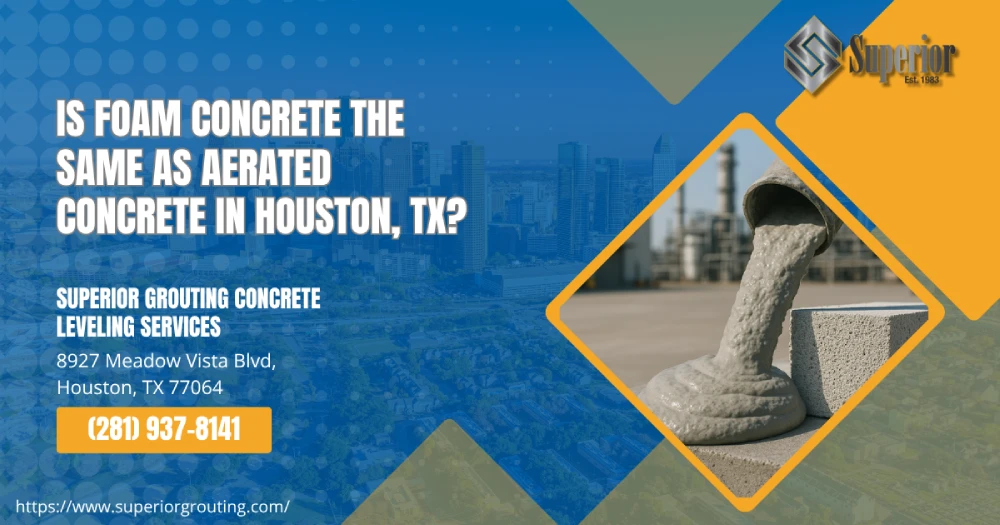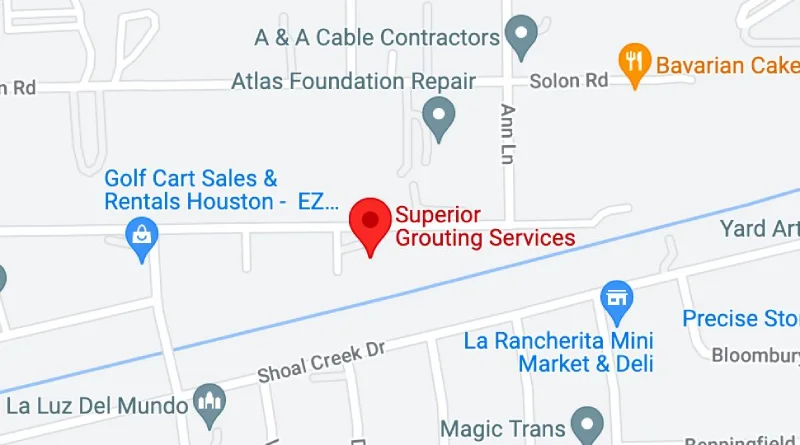Is Foam Concrete the Same as Aerated Concrete in Houston, TX?

Foam concrete and aerated concrete are two labels for the same innovative material. In Houston’s fast-moving construction sector, you will also hear the terms cellular concrete, foamed concrete, lightweight concrete, and even aircrete. Regardless of the name, the resulting concrete is a low-density mixture of cement, water, and preformed foam that traps billions of tiny air voids. Those controlled voids slash weight, enhance thermal insulation, and simplify pumping compared to traditional concrete.
Below, we explore the composition of cellular concrete, how it is produced, the wide range of applications, and the compelling benefits of cellular concrete for Gulf Coast infrastructure. Throughout this discussion we will weave in critical metrics—pounds per cubic foot (pcf), compressive strength, thermal conductivity, and fire resistance—to show why this type of concrete stands apart.
Concrete, Cellular Concrete, and Foam: Sorting Out the Terminology
The concrete industry uses “cellular” to emphasize the engineered air cells, “foam” to highlight the foaming agent, and “aerated” to reference the process of aeration. Add “autoclaved aerated concrete” (AAC) to the mix and confusion grows. AAC is cured in a pressure vessel, while most Houston contractors rely on non-autoclaved cellular concrete that cures in place like conventional concrete.
Whichever production route you pick, the concrete structure gains a lightweight yet stable cellular matrix that performs well in various construction scenarios—from pipeline abandonment to large roof decks.
Composition of Cellular Concrete
- Portland cement or blended cement provides the primary binder.
- Fine aggregate or none at all, depending on the target density.
- Water to reach the desired water-to-cement ratio.
- Preformed foam created by a protein-based or synthetic foaming agent.
- Optional admixtures such as plasticizers, accelerators, or fibers to achieve high strength, durability, and quality control.
Because cellular concrete requires less raw material by volume than conventional concrete, every cubic yard delivers environmental advantages—lower embodied CO₂ and reduced trucking.
The Process of Cellular Concrete Production
- Step 1: Prepare a cementitious slurry (cement, water, and possibly fine aggregate).
- Step 2: Generate stable preformed foam at a calibrated density—usually 2.5 to 3.0 lb/ft³.
- Step 3: Inline mix the foam into the slurry until the composite reaches the specified target, often 25 pcf for geotechnical fills or 90 pcf for structural roof screeds.
- Step 4: Pumped or poured into place, the mixture self-levels and requires no vibration.
- Step 5: Cure under moist or covered conditions to protect against rapid moisture loss.
Ensuring that the concrete achieves its design density and compressive strength hinges on field tests every 50 to 100 cubic yards. ASTM C869 outlines density checks per cubic foot, while ASTM C495 governs cylinder testing.
Benefits of Cellular Concrete for Houston Construction
Lightweight Nature Makes Transport and Placement Easy
Unit weights ranging from 20 to 120 pcf let engineers cut dead-load by up to 70 percent compared to traditional concrete. A lighter slab or fill reduces load on weak clay soils commonly found along Buffalo Bayou and the Ship Channel.
Excellent Thermal Insulation and Fire Resistance
Thermal conductivity drops to as low as 0.4 Btu in/hr ft² °F, offering excellent thermal insulation for cold-storage warehousing. At the same time, the cellular structure gives two-hour fire resistance without extra coatings—critical for petrochemical facilities that must meet stringent building code requirements.
Superior Pumpability and Speed
Cellular concrete can flow 600 ft horizontally and 80 ft vertically through a 2-in. hose, so crews finish large placements quickly. The material’s self-consolidating behavior eliminates the need for internal vibration, saving labor and reducing noise transmission on busy job sites.
Strength and Durability with Proper Mix Design
Although low density ordinarily means lower compressive strength, Houston suppliers routinely deliver 400 to 1,200 psi mixes that satisfy geotechnical and structural design of the building envelope. Reinforced concrete elements—such as precast panels—often use 90 pcf cellular concrete paired with welded wire fabric for added flexural capacity.
Environmental and Economic Value
Lightweight aggregate is scarce along the Gulf Coast, and importing it is costly. Cellular concrete relies on locally sourced cement and water plus a foaming agent, so the price per square foot remains competitive. Using cellular concrete decreases material consumption per cubic yard, trimming carbon footprints and helping contractors meet sustainability certifications.
Using Cellular Concrete in Construction: Key Applications
- Geotechnical fills over soft soils where low density and thermal stability limit settlement.
- Void filling for abandoned pipelines, tunnels, and culverts—cellular concrete flows easily and insulates the void space, preventing future collapse.
- Roof insulation screeds that combine structural capacity with lightweight insulating properties, allowing a single material to act as both deck and thermal barrier.
- Precast modular blocks and wall panels for industrial buildings, providing excellent thermal insulation while meeting high strength demands.
- Trench backfill around electrical and data conduits to reduce lateral earth pressure and ease future excavation.
Because the mixture of cement, foam, and water can be fine-tuned, different concrete types emerge from the same mobile batch plant, supporting various construction applications during one mobilization.
Density, Compressive Strength, and Other Performance Metrics
| Density (pcf) | Typical Compressive Strength (psi) | Common Use |
| 25 pcf | 100–200 psi | Mass void filling, lightweight insulating fill |
| 40 pcf | 250–400 psi | Buried utility encasement, low-load roof decks |
| 60 pcf | 500–700 psi | Precast wall panels, pump stations |
| 90 pcf | 900–1,200 psi | Composite floors, structural roof toppings |
Selecting the right density allows designers to balance weight, strength, and insulation without sacrificing durability.
Insulation, Acoustic Control, and Noise Reduction
Closed-cell air pockets insulate against heat flow and reduce airborne sound by up to 10 dB compared to conventional concrete of equal thickness. That performance helps industrial plants comply with OSHA noise limits while also cutting HVAC costs. On multilevel parking structures, using cellular concrete slabs can reduce structure-borne noise transmission to offices below.
Quality Control Considerations
- Verify preformed foam stability on every load—collapse can increase density and reduce thermal insulation properties.
- Check yield per cubic yard to ensure the concrete allows sufficient coverage of the total floor area.
- Monitor curing temperature; hot Gulf weather accelerates hydration but can also desiccate the surface.
- Maintain detailed batch tickets—density, pcf, water-cement ratio, ambient temperature—to document compliance with the building code and client specifications.
Potential of Cellular Concrete Compared to Traditional Concrete
When compared to traditional concrete, cellular concrete offers:
- 30–50 percent lower raw material extraction
- Reduced cement factor per cubic yard
- Faster installation cycles that shorten the critical path
- Improved thermal insulation without separate insulating board
- Lower risk of segregation because the process involves mixing foam uniformly before discharge
These advantages make cellular concrete in construction a compelling choice for designers aiming to optimize structural efficiency, environmental stewardship, and cost control simultaneously.
Conclusion: Why the Construction Sector Is Embracing Cellular Concrete
From the Port of Houston to I-10 bridge approaches, cellular concrete offers a unique combination of low density and thermal performance. Its cellular structure delivers high strength where needed, resists moisture, and meets stringent fire ratings.
As the concrete industry confronts demands for greener building materials, cellular concrete stands ready—with excellent thermal insulation, reduced pcf, and the ability to be pumped or poured into place quickly. Whether your next project calls for geotechnical fills, lightweight insulating roof decks, or large precast elements, the benefits of cellular concrete are difficult to ignore.


